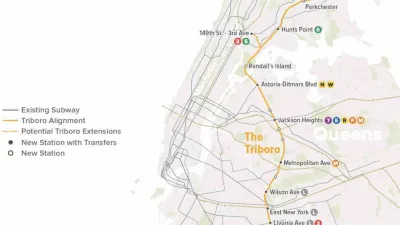The Regional Plan Association presents the details of a plan to build a rail line connecting the Bronx, Queens, and Brooklyn: the Triboro Line.

A recent policy brief shares the most recent analysis by the Regional Planning Association (RPA) into the Triboro Line proposal—a circumferential transit line connecting the three New York City boroughs of Brooklyn, Queens, and the Bronx, with a possible extension to Staten Island as well.
The brief begins by establishing the need for the project:
The majority of people living in the four boroughs outside Manhattan don’t use public transit to travel to work within the boroughs, even though they live in the city with the largest subway and bus network in the U.S. Why? Because New York City’s subways were designed to bring people into Manhattan, not to move them between other boroughs, and the buses that serve the boroughs are slow and unreliable.
According to the RPA brief, the Triboro Line could potentially offer "fast, convenient and direct transit connection" between the Bronx, Queens, and Brooklyn. The RPA first proposed the idea in A Region at Risk: The Third Regional Plan for the New York-New Jersey-Connecticut Metropolitan Area as an above-ground line, planned to take advantage of underused and abandoned rights-of-way.
The paper includes presents the case for the line, using infographics and lots of data to back up its argument, including why the proposal relies on rail and how it would mix passenger and freight rail along its 24-mile route.
FULL STORY: The Triboro: Transit for the Boroughs

Planetizen Federal Action Tracker
A weekly monitor of how Trump’s orders and actions are impacting planners and planning in America.

Map: Where Senate Republicans Want to Sell Your Public Lands
For public land advocates, the Senate Republicans’ proposal to sell millions of acres of public land in the West is “the biggest fight of their careers.”

Restaurant Patios Were a Pandemic Win — Why Were They so Hard to Keep?
Social distancing requirements and changes in travel patterns prompted cities to pilot new uses for street and sidewalk space. Then it got complicated.

DC Area County Eliminates Bus Fares
Montgomery County joins a growing trend of making transit free.

Platform Pilsner: Vancouver Transit Agency Releases... a Beer?
TransLink will receive a portion of every sale of the four-pack.

Toronto Weighs Cheaper Transit, Parking Hikes for Major Events
Special event rates would take effect during large festivals, sports games and concerts to ‘discourage driving, manage congestion and free up space for transit.”
Urban Design for Planners 1: Software Tools
This six-course series explores essential urban design concepts using open source software and equips planners with the tools they need to participate fully in the urban design process.
Planning for Universal Design
Learn the tools for implementing Universal Design in planning regulations.
Heyer Gruel & Associates PA
JM Goldson LLC
Custer County Colorado
City of Camden Redevelopment Agency
City of Astoria
Transportation Research & Education Center (TREC) at Portland State University
Camden Redevelopment Agency
City of Claremont
Municipality of Princeton (NJ)




























